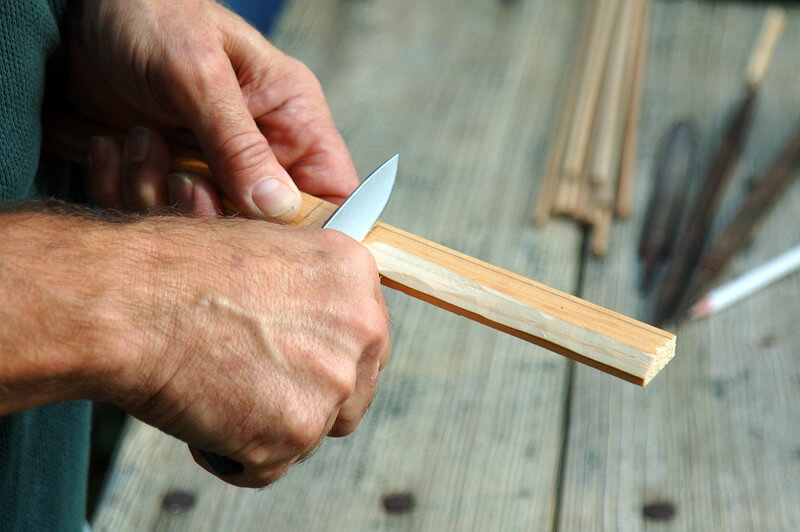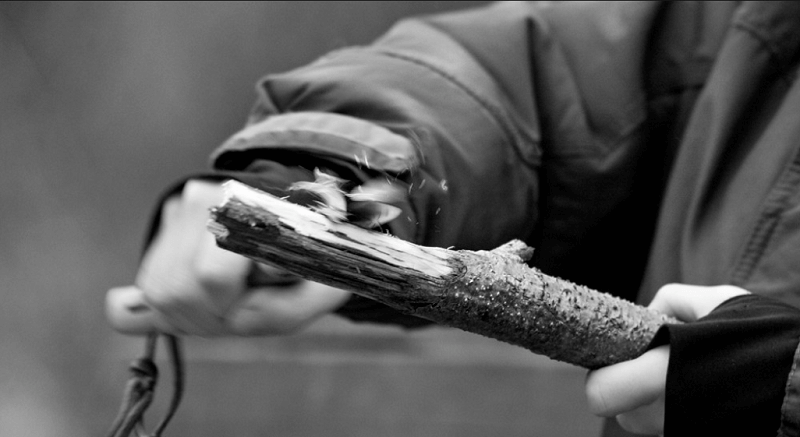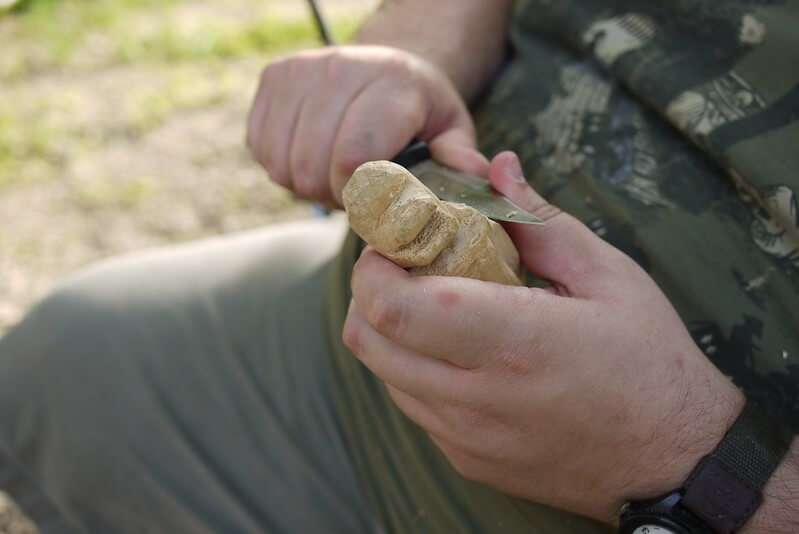Whittling and woodcarving make for a great hobby or pastime while creating cool figures and objects out of wood. Learning the traditional craft of whittling as a beginner might seem like an uphill task. However, this post will break down the basics and how to get you started in whittling.
What is Whittling?
Whittling can best be described as the craft of woodcarving using only a carving knife. Most beginners ask the first question while starting in whittling: “woodcarving and whittling are the same.”
Though some people use these terms interchangeably, woodcarving involves the use of chisels, mallets, gouges, while whittling entails only making use of a knife to carve wood. Woodcarving can also involve the use of power equipment like lathes and chainsaws.

Whittling is easier than woodcarving and will vary from sharpening a stick to transforming a block of wood into impressive stuff like a spoon collection, figurines, and other objects.
> Recommended Reading: History of Whittling
Tools for Whittling & Beginner Whittling Kits
The best part about whittling is you do not need much to get started.
All you need as a beginner to whittle is a quality knife, some wood, tools to keep your knives sharp, and some form of safety protection, like gloves.
When starting out, going for a beginner whittling kit gives you everything you need to get started. However, you can also buy a whittling specialty knife or a pocket knife to get you started. For knives, it is better to use a knife with a Rockwell Hardness (HRC) of between 58 and 62. This range is the best to balance both edge retention and hardness without getting too brittle to carve with.
Pocket Knives
A pocket knife is the most basic blade you can use for whittling. It is easy to store and carry around, and some include various blades that can offer different whittling cuts. Pocket knives are designed only for whittling, making it easier to slice wood.
If you’re looking for the best pocket knife for whittling, I recommend the Flexcut Tri-Jack. This knife is designed for carving wood out of the box. It comes with three differently sized knives and has a liner lock designed to ensure blades don’t harm your fingers.
The Old Timer 440T Workmate is your best bet for a cheaper, beginner-friendly pocket knife. The pocket knife comes with different blades, which maximize your whittling potential. It is also very affordable and durable. However, the build quality is not the best, although it can handle everyday use.
> Recommended Reading: Best Pocket Knives for Whittling
Specialty Whittling Knives
Unlike pocket knives, specialty whittling knives have fixed blades and do not fold. This means they are a little more robust than pocket folding knives because of a fixed blade. The fixed blade is also a good safety feature because it stops the knife from accidentally closing on your finger. Another good thing about specialty knives is the handle. Curved and comfortable handles mean you can whittle for long sessions without fatigue.
If you’re looking for a good whittling knife, Helvie knives are the way to go. Their knives are what is considered the premium in whittling and wood carving. The knives’ details, razor-sharp blade, hold an edge and are professionally honed.
Flexcut whittling knives are the best and easiest to get in the market for a beginner. Flexcut is a prolific carving brand, and its knives can be purchased at different wood carving outlets. Flexcut knives are also very cheap hard to beat if you want a great starter kit. You can check out the Flexcut Beginner Palm & Knife Set, which is a good deal to get you started.
Apart from pocket knives and specialty knives, curved knives are also great if you’re looking to start spoon carving. Read more about the different types of carving knives.
Whittling Kits
A whittling starter kit is the simplest way to get into whittling without much hassle. Whittling kits include the basic tools to get you started. Different types of whittling knives, knife sharpening tools, and some whittling kits include basswood and simple carving plans to get you started.
A good beginner whittling kit I would recommend is the BeaverCraft S15. This whittling kit comes with three knives, a leather strop to keep the knives sharp, and a pouch to store tools safely and securely. The knives are well made, and the handles are comfortable to hold even for long whittling sessions.
Another wood whittling kit you can check out is the Cor Cordium Whittling Kit. It’s from a less known company but offers more in a single package. With the Cordium Whittling kit, you will receive three knives, eight blocks of basswood, safety gloves, polishing and sharpening compound, and a pouch to store all these safely.
Whittling Safety
A sharp whittling knife should encourage you to get protective gear and keep your fingers safe from the blade. Until you get better at whittling, a beginner wearing a pair of safety gloves, thumb guards, or cut-resistant tape is recommended. Gloves might seem cumbersome at first, but with time you will adjust.
Here are some whittling safety tips to keep you safe and enjoy your new whittling hobby.
- Get comfortable with your feet on the floor.
- Cover your lap with protective gear. I have heard horrific stories of gashed thighs when sharp whittling knives slip out.
- Wear cut-resistant gloves or a thumb guard to protect your fingers. See our best wood carving gloves.
- Cutaway from the body
- Making small careful cuts takes your time
- Keep your blade’s edge sharp. Dull knife edges are difficult to control when used.
- If the knife drops, let it fall
- Keep your knife safe when not in use.
> Recommended Reading: Best Gloves for Wood Carving
Beginner Whittling Cuts
Time to start whittling. There are three basic whittling cuts a beginner should aim to perfect. These cuts are rough cutting, pull stroke (pare cut), and push stroke (thumb pushing).
Rough Cutting

This type of cut is performed at the beginning to get a basic outline and form of your project. You will make long sweeping cuts away from your body in rough cutting. Do not cut the wood deeply to avoid splitting. Gradually remove slices of wood to create a general shape you would like to achieve.
Pull Stroke (Pare Cut)
Pull stroke or paring cut is one of the most used cuts when whittling. However, it does not allow you to do precise cuts and put more strength on the whittling knife. The paring cut is similar to the process of peeling a potato. When whittling, the blade of your knife should go towards the thumb of the same hand holding the knife.
Because the thumb will stop the knife, you should wear a guard thumb to avoid an emergency for safety reasons.
Push Stroke (Thumb Cut)
This is one of the important whittling cuts you should perfect. First, it allows you to put extra pressure on the knife and cut through hardwoods. Second, you have extra control over the knife, which helps you do precise details on your project.

In push stroke cut, you are pushing the blade away from you. The thumb of your non-cutting hand gives the extra power by pushing on the back of the knife. The cutting hand then steers the knife for those smooth and small cuts on your project.
Whittling Tips for Beginners
- Make sure the wood you are using is dry. Wet wood can warp or fracture when dried out.
- If you’re having a problem achieving great detail because your wood is hard, then try employing a 50/50 mixture of alcohol and water.
- Consider using sculpting handwear/gloves to avoid injury. If you decline to wear gloves, think of wearing a thumb pad. If you don’t intend to put on a thumb pad, at least shield your thumb under some layers of duct tape.
- Don’t hurry. Make regulated cuts and remove wood in thin layers or risk tearing the wood and leaving ugly marks behind.
- To keep your hands free when whittling, use a clamp or vice appliance to anchor the wood to a solid surface.
- Sharpen your knife regularly. If you observe that it’s an obstacle to making your cuts, it’s most likely that your blade needs to be honed.
- Don’t expect to master this skill overnight. Wood sculpting needs a lot of practice as well as perseverance. Good carving originates from experience as well as persistence. So don’t get frustrated if whittling doesn’t come to you as fast as you desire. Continue working on your skills, and you will get there.
> Recommended Reading: Wood Carving Tips for Beginners